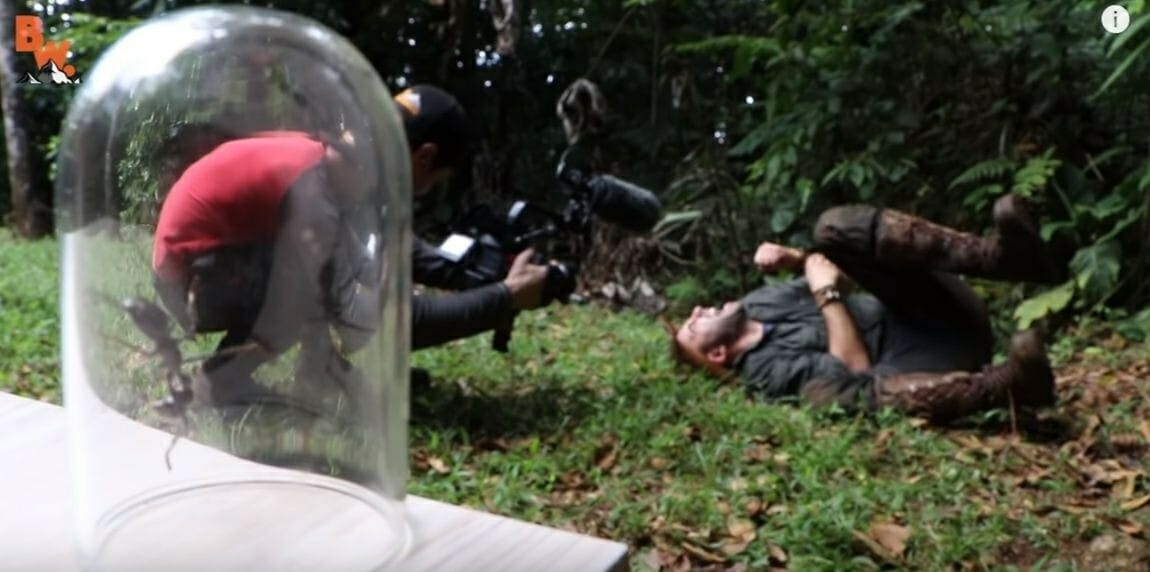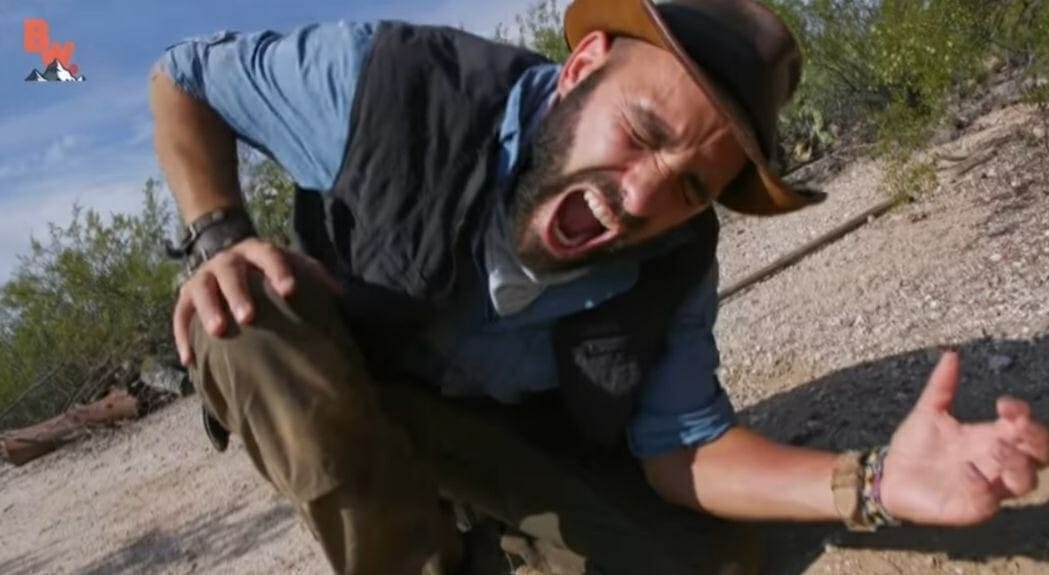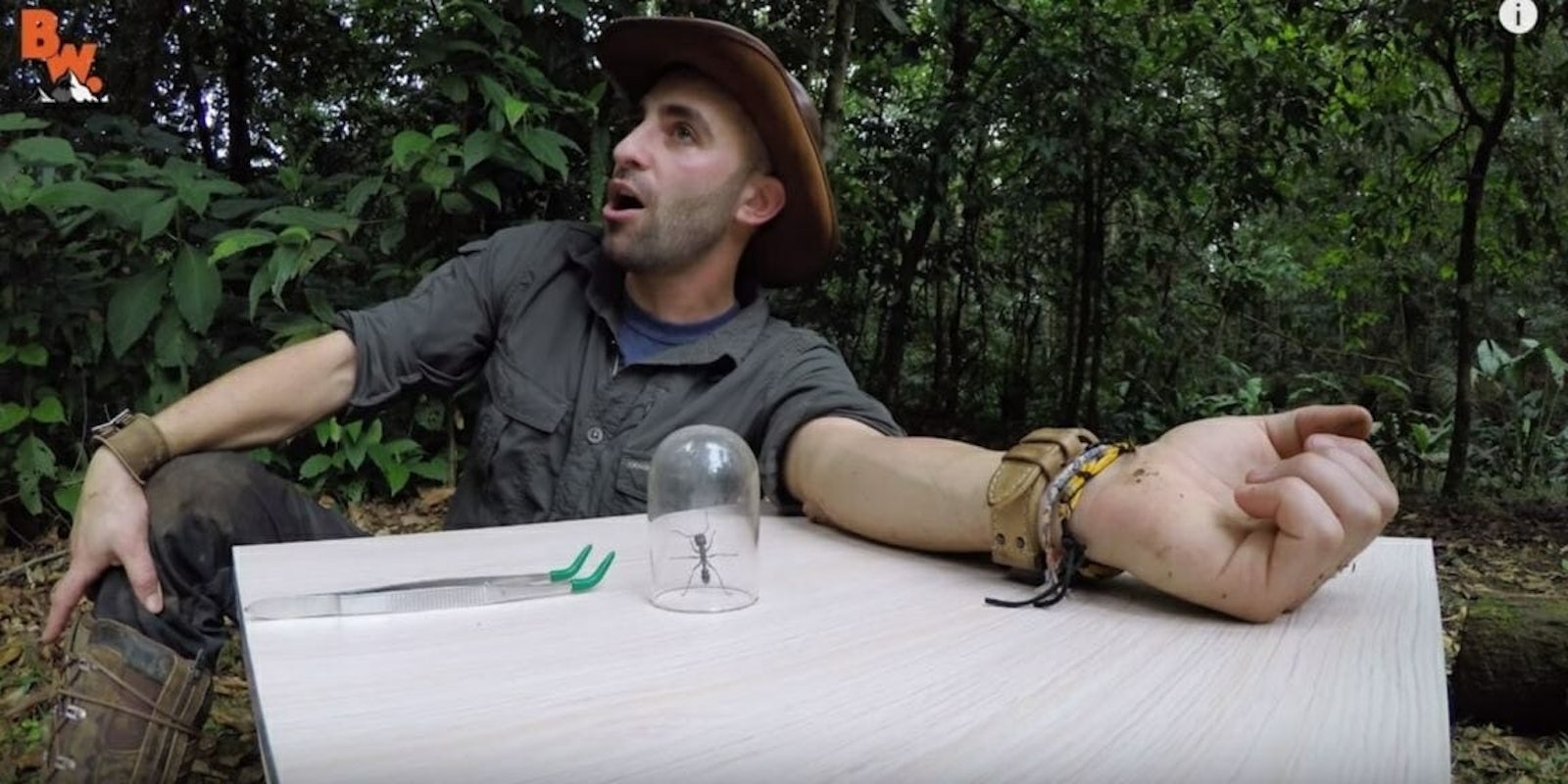Coyote Peterson is honest about his YouTube channel. He’s honest about what works for viewers, and what doesn’t. He’s honest about his YouTube strategy. And he seems honest—and earnest —when he says he’s done with the genre of videos that have made him most famous and brought him the most views.
Those videos in which he allows the insects with the most painful bites in the world to chomp on his arm? He’s over it.
“I can certainly find more things to bite and sting me,” Peterson told the Daily Dot recently. “That’s not a problem. But in my opinion, it has a shelf life. I don’t want to be the person who couldn’t let go of being stung. I want to be the person who gets into the water with a great white, the sort of person who can catch an anaconda with my bare hands. We want people to see us as the greatest animal show that’s ever been produced, and we’ll continue to try to ride that for as long as we can.”
But if Peterson is honest with himself, he knows people love to watch him take the sting of these frightening, almost otherworldly creatures and then fall to the ground in agony. That’s how he built his name as YouTube’s most prominent animal adventurer—he’s kind of a combined Jack Hanna and Steve Irwin for the internet age—and it’s a big reason he has more than 13.6 million subscribers and nearly 2.5 billion views on his Brave Wilderness channel.
If we’re being honest with you, they’re richly entertaining. Which is why this video of a tarantula hawk stinging him has more than 44 million views.
And why this video of a bullet ant biting him has accumulated more than 40 million.
Journeying to the Sonoran Desert in Arizona or the jungles of Costa Rica to find insects to feast on him probably isn’t what a young Coyote Peterson, whose real name is Nathaniel Peterson, envisioned for himself when he was exploring the woods around his childhood home in Newbury, Ohio.
Newbury is so tiny that Peterson said it didn’t have a fast food restaurant. He called it a quaint, quiet place where you had to drive to another city to experience any kind of nightlife. But he also called it a phenomenal playground with miles of woods and undeveloped wilderness. There were creeks. There were forests. There were ponds. And there were ancient beasts.
More than anything, his main goal as a child was to catch a snapping turtle, the most dangerous creature he had a chance of finding. One day, as an 8-year-old, he spotted a 40-pounder, a being almost as big as he was. Peterson had tried catching this particular turtle before but he had always failed to grab hold of it. On this day, though, the turtle was hiding under the algae with only its shell floating above the water’s surface. Peterson grabbed its tail and fought him until he conquered the beast and hoisted it out of the water.
“It was like pulling a dragon out of nowhere,” Peterson said. “The turtle was looking at me like, ‘How did this 8-year-old kid catch me?’ You realize it’s a creature that evolved over hundreds of millions of years, and we had some kind of connection.”
That connection eventually led him to a YouTube career. But not just a YouTube career. Peterson also starred in a four-part series on the platform called Jurassic World Explorers in which he partnered with the movie franchise. He’s written a book called King of Sting. And he’s fulfilling a lifelong dream to star in a show on the Animal Planet network that will allow him to travel around the world and teach about the mesmerizing creatures that inhabit it.
He created his YouTube channel in 2014, in part because he couldn’t develop his ideas as a TV series. He was told nobody was interested in that kind of animal education content, and though he viewed YouTube at the time as a haven to watch cat videos and lowbrow content, he eventually got started.
That’s when he found he had developed a niche that he could fill with evergreen content, meaning the videos he posted in 2016 could still be relevant (and entertaining) in 2019 and 2026.
“We found this magic gap in the world of YouTube,” Peterson said.
In 2014, the Brave Wilderness channel launched a video where he was quilled by a porcupine. That vlog drew more than 30 million views, by far the most of any content he had previously released. Soon after, he took to the challenge of experiencing insects that reside at the top of the Schmidt sting pain index, basically a chart of the creatures that inflict the most painful bites or stings. To Peterson, producing that kind of content was a risk. Not just because of the immense pain he was sure to feel.
“When we launched the whole bite and sting content, it was a real gray area,” Peterson said. “The audience was going to embrace it or they were going to immediately be like, this does not work for us. But I find in many instances, especially with kids, they find it amusing—as in hilarious. A grown man rolling around on the ground in pain.”
The point Peterson was trying to make was that his videos also have an educational twist, where he’s laying out the idea that the insects are more afraid of you than you are of them and that if you leave them alone, you probably won’t have to experience anything on the sting pain index.
The videos are suspenseful and fun and cringe-worthy (it’s not unlike a horror film), and yet he never curses in the aftermath because he knows using a swear word to amplify the moment doesn’t actually hold any value for his content.
He let a tarantula hawk, an insect that can put a human into paralysis for up to five minutes, sting him. He allowed a cow killer ant to use the longest stinger in the world to pierce his skin. He watched a bullet ant bite him, the kind of pain that put Peterson on the ground like he had just been punched out by Mike Tyson.

He’s experienced the pain of a Japanese giant hornet, the same kind that’s killed people in Asia. And finally, the giant desert centipede where he nearly broke out in tears and had to use a venom extractor and call for medical attention for the first time.
Here’s how that bite felt.

Despite all of the stinging success, Peterson has wound down his bite and sting coverage. Sure, the pain of the bites are surely salved by the tens of millions of pageviews those videos collect, but Peterson has a different strategy.
“To us, it feels like the end of a book that we’ve been building for four years,” he said. “The audience loves the content, whether we do bites and stings or not. They gravitate toward the sting content. But it’s not as advertiser-friendly. They’d rather me cuddle a baby sloth.”
Peterson said there might be a backlash to the end of his painful content, but he also wonders, “How many years can you be the guy who gets bitten and stung?”
So, Peterson will move to the next phase of his career. It’ll still involve YouTube, but he’ll also enjoy a bigger budget, more variety, and more mainstream exposure on Animal Planet.
But he also hasn’t forgotten the thrill he experienced when he searched for snapping turtles as a boy in the woods of rural Ohio. Even to this day, it’s his favorite hobby. When he’s not working and filming, he loves climbing into a kayak and searching for those ancient beasts. It’s because of the honest-to-goodness connection he once felt when he caught his first snapping turtle. He’s a strategist, but this is not a career he could have ever envisioned.
Turns out, when he caught the snapping turtle, Peterson was actually the one who got hooked.


